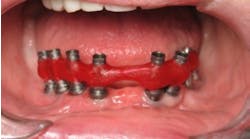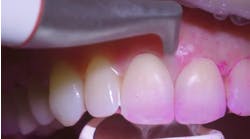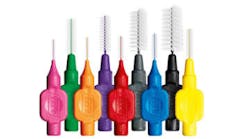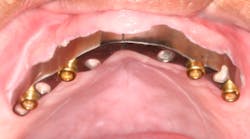Periodontal abscess, endodontic abscess, or a combination: How to decipher
The relationship between periodontal disease and pulpal infection occurs primarily by the intimate anatomic and vascular interactions between the pulp and the periodontium. As such, when we as dentists see these periapical lesions affecting the periodontium and the apical tissue, proper diagnosis and treatment is of utmost importance if we are to give the affected tooth a hopeful prognosis.
RELATED |Inflammation of the gingiva: The other reasons besides the obvious
In 1972, Simon, Glick, and Frank published a paper titled “The Relationship of Endodontic-Periodontic Lesions” in which they delineate five classifications of lesions. The classifications are: 1) primary endodontic lesion, 2) secondary periodontal lesion, 3) primary periodontal lesion, 4) secondary endodontic lesion, and 5) combined lesion. These classifications are based on the theoretic pathways explaining how these radiographic lesions are formed. By understanding the pathogenesis, the clinician can then suggest an appropriate course of treatment and assess the prognosis.
RELATED |I'll have a maxillary anterior implant to go; please hold the periodontal treatment
In primary endodontic lesions, there is an acute exacerbation of a chronic apical lesion. Patients tend to experience varying degrees of pain. When tested, the pulp is necrotic. Drainage can be seen through the PDL into the gingival sulcus or as a swelling in B/L attached gingiva. A sinus tract may be present and is usually associated with deep pocket depths. Radiographic bone loss will vary, depending on the avenue of fistulation. A radiolucency may be present and is consistent with the origin of the lesion. It is imperative to trace the sinus tract with gutta percha and take a radiograph to determine the origin of the lesion. Typically, lesions will heal with endodontic therapy.
Primary endodontic lesions with secondary periodontic involvement occur when primary endodontic lesions are left untreated. They may also be caused by root fractures, root perforations, or misplaced pins. In these cases, plaque biofilms invade through a sinus tract or sulcus, leading to marginal periodontitis. Pulpal necrosis is seen in these cases and the teeth may present with apparent radiolucency from apex to sulcus and decreased crestal bone levels. Treatment for these cases requires both endodontic and periodontal therapy.
Cases with primary periodontic lesions are generally caused by untreated periodontal disease. Here we see periodontal destruction progress toward the root apex. A periodontal evaluation reveals clinical attachment loss, deep pocket depths, infrabony defects, and often subgingival calculus. When the pulp is tested, we see a vital pulp. Radiographic bone loss is seen and periapical radiolucency may be present.
Primary periodontic lesions with secondary endodontic involvement are seen when apical progression of the periodontal pocket reaches the apical tissues. The pulp may become necrotic as periodontal pathogens invade through lateral canals, accessory canals, or the apical foramen. Pulpal necrosis may also occur from periodontal procedures where the blood supply through an accessory canal or the apex is severed by a curette or other periodontal instrument. These teeth are generally radiographically similar to an endo-perio lesion. Treatment would involve endodontic therapy preceding periodontal therapy.
True combined lesions rarely occur. These are formed when endodontic lesions progress coronally and join with an infected periodontal pocket that is progressing apically. The pulp is necrotic in these teeth. Treatment would include endodontic therapy preceding periodontal therapy. The overall prognosis depends on periodontal status, though it is generally guarded due to the severity of periodontal destruction.
In summary, diagnosis is paramount to determining the course of treatment and overall prognosis. Treatment of perio-endo lesions requires a multidisciplinary collaboration between the endodontist, periodontist, and restorative dentist. In general, when an endodontic component is present, root canal therapy should be performed first, followed by reevaluation of periodontal status and any necessary periodontal intervention.







